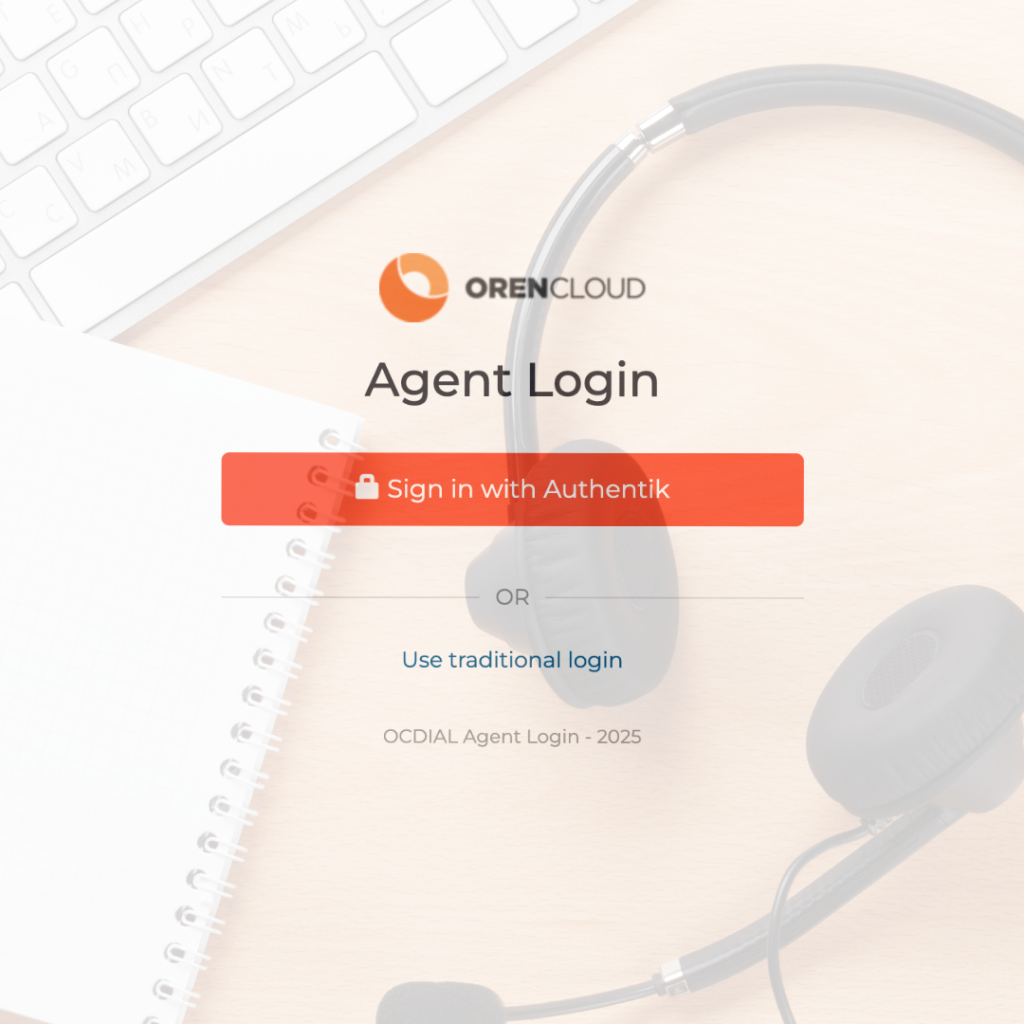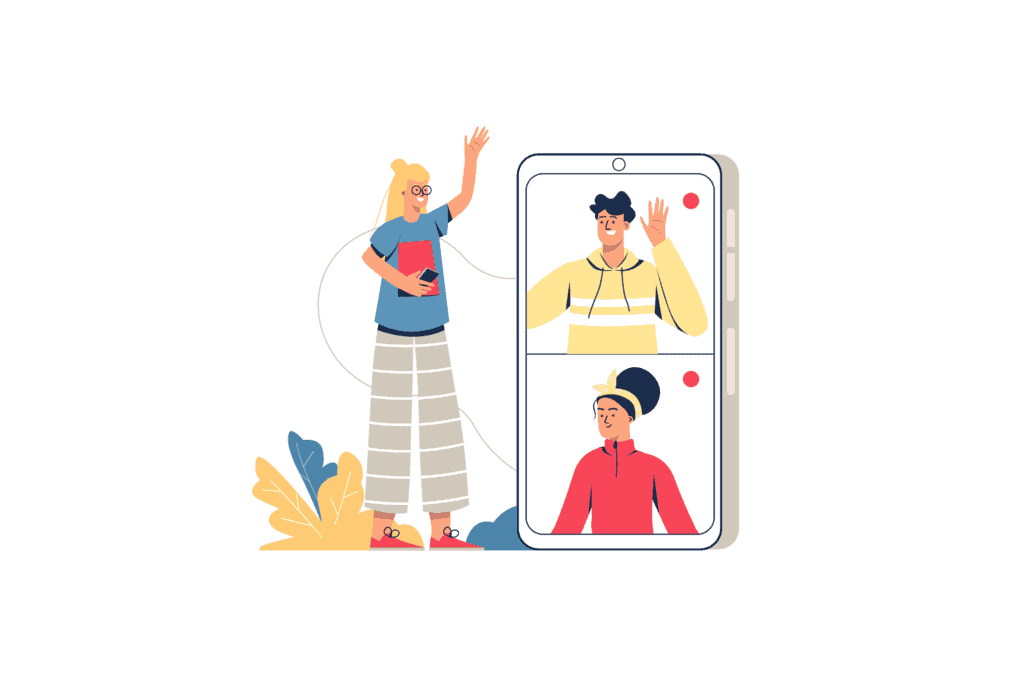VICIDIAL has long been recognized as one of the most powerful open-source contact-center platforms, delivering enterprise-class telephony features with the flexibility of Asterisk. Yet despite its technical depth, the default VICIDIAL interface has remained largely unchanged since the mid-2000s — lacking the modern user experience, responsive layouts, and authentication standards expected in enterprise environments.
OCDIAL 3.0 represents a complete modernization effort led by ORENCloud, combining a ground-up UI redesign with secure, centralized authentication powered by Authentik SSO. The result is a polished, enterprise-ready platform that blends VICIDIAL’s proven reliability with next-generation usability and security.
The Challenge with Traditional VICIDIAL Deployments
Although VICIDIAL remains a capable solution for outbound and inbound call centers, its traditional interface and architecture pose several limitations in modern IT ecosystems:
Outdated UI/UX: The interface still reflects early-2000s design paradigms, limiting operator comfort and efficiency.
No OAuth2/OIDC support: VICIDIAL natively lacks modern authentication protocols required by enterprise SSO systems.
Separate logins: Agents and administrators log in through different portals, complicating user management.
No centralized identity management: Password resets and account creation must be handled manually.
Difficult enterprise integration: Native compatibility with LDAP, Azure AD, or Okta is absent.
Limited mobile responsiveness: Interfaces do not scale elegantly across devices.
Inconsistent experience: The agent, admin, and webphone interfaces vary in style and behavior.
For IT managers tasked with maintaining security compliance or unified identity policies, these gaps make traditional VICIDIAL deployments increasingly challenging.
OCDIAL 3.0: Complete UI Transformation
Design Philosophy
Key design goals include:
Ultra-flat UI: Clean lines, minimal shadows, and sharp visual hierarchy.
Consistent branding: Customizable color schemes and typography (Roboto + Montserrat).
Accessibility: Improved contrast, keyboard navigation, and form focus states.
Responsive layouts: Dynamic resizing for different resolutions and screen orientations.
Agent Interface (
agc/ocdial.php
)
Streamlined login with SSO integration via Authentik.
Collapsible phone panel for expanded workspace.
Re-engineered buttons with uniform sizing and intuitive color cues.
Modern typography and iconography for a professional look.
Favicon and mobile touch-icon support for progressive-web-app-like usability.
Admin Panel (
ocdial/admin.php
)
Unified interface for all management tools.
Gradient login backgrounds with branded elements.
DataTables integration for faster sorting and filtering.
Consistent layout across user management, campaigns, and reports.
Dark Mode Support
Agents working long shifts benefit from system-wide dark mode, implemented with CSS variables and localStorage persistence. All UI components — menus, modals, webphone, and buttons — transition seamlessly between themes without reloading.
Webphone Interface
The built-in webphone mirrors the main UI aesthetic, synchronizing dark-mode preferences and improving visibility during live calls.
Technical Highlights
Custom CSS (style_comfortable.css, 2200 lines)
Cache-busting via versioned query strings (?v=)
JavaScript-driven theme toggles
Optimized asset loading for reduced latency
Authentik SSO Integration: Enterprise-Grade Authentication
Why Authentik?
Authentik is a modern, open-source Identity Provider (IdP) supporting OAuth2, OpenID Connect (OIDC), LDAP, and SAML. It allows self-hosting for full data sovereignty while integrating easily with enterprise systems such as Active Directory, Azure AD, or Okta. Authentik provides a unified identity plane across all business applications — and now, through OCDIAL 3.0, across VICIDIAL too.
Technical Architecture
Unified Login System
OCDIAL merges native and Authentik authentication flows into a single portal:
Detects whether SSO or local login applies.
Redirects to Authentik for authorization.
Exchanges the authorization code for tokens.
Validates and establishes a PHP session.
Falls back gracefully to native auth if SSO is unavailable.
OAuth2/OIDC Implementation
Authorization Code Flow + PKCE for maximum security.
JWT token verification and expiration handling.
CSRF protection via validated state parameters.
Automatic token refresh and logout synchronization.
User Provisioning & Mapping
Authentik user claims are matched or used to create VICIDIAL users automatically, preserving roles and groups. Attributes such as email, full name, and department are mapped to VICIDIAL’s internal permissions.
Key Files
authentik_config.php — OAuth2 credentials and environment variables
authentik_callback.php — token exchange handler
authentik_session_check.php — session validation middleware
authentik_lib.php — shared functions
admin_login_secure.php — SSO-only login path
Security Measures
Session-based token storage (never client-side).
Config-driven credentials — no hard-coded secrets.
Token revocation on logout.
Automatic session expiration.
Database Integration
OCDIAL 3.0 synchronizes Authentik users with the existing vicidial_users table. Logins are recorded in vicidial_user_log for audit trails. Role and group mappings maintain compatibility with VICIDIAL’s native permissions.
// Example OAuth2 config
define('AUTHENTIK_CLIENT_ID', 'your-client-id');
define('AUTHENTIK_CLIENT_SECRET', 'your-client-secret');
define('AUTHENTIK_ISSUER_URL', 'https://auth.yourdomain.com');
define('AUTHENTIK_REDIRECT_URI', 'https://dialer.yourdomain.com/authentik_callback.php');
define('OAUTH_SCOPES', 'openid email profile');Deployment Flexibility
Dual-mode auth: SSO + native or SSO-only.
Zero impact on Asterisk telephony engine.
Backward compatible with existing campaigns.
Key Benefits and Features Summary
For Agents
One-click login via Authentik SSO — no password fatigue.
Modern flat UI with dark mode and mobile responsiveness.
Faster navigation and reduced eye strain.
For Administrators
Centralized user and role management through Authentik.
Audit trails for logins and session events.
Reduced password reset tickets (≈ 80 %).
Seamless provisioning and offboarding.
For Organizations
Enterprise-grade security via OAuth2 and OIDC.
Compliance with identity governance standards.
Fully self-hosted for data privacy and control.
Cost-effective modernization of existing infrastructure.
Technical Advantages
Compatible with all VICIDIAL features and Asterisk versions.
No telephony engine modifications required.
Clear separation of UI and authentication layers.
Implementation Highlights
Technologies
PHP 7.4+ with mysqli
Bootstrap 3.4.1, jQuery 3.6.4, DataTables
CSS3 with custom variables
ES6 JavaScript modules
Server Requirements
Linux server (openSUSE, CentOS, Ubuntu)
Apache/Nginx, PHP 7.4+
MySQL/MariaDB
Asterisk PBX
Authentik SSO instance
Deployment
Zero-downtime migration
Progressive enhancement approach
Version-controlled configuration
Comprehensive backup support
Use Cases and Applications
OCDIAL 3.0 is ideal for enterprises and BPOs that demand secure, scalable and modern contact center operations.
Enterprise Call Centers: Seamless SSO with centralized ID management.
Multi-Tenant Deployments: Tenant-based Auth integration and branding.
Remote Teams: Secure access through browser-based SSO.
Regulated Industries: Healthcare, Finance, Government compliance.
Why Choose ORENCloud for Implementation
Our Expertise
ORENCloud has over seven years of deep experience in VICIDIAL customization and Asterisk architecture. Our team specializes in SSO integrations, UI/UX modernization, and secure infrastructure deployment.
What We Offer
Custom VICIDIAL Modernization
– Brand-aligned UI/UX redesign
– Responsive interfaces and dark mode
SSO Integration Services
– Authentik, Keycloak, Okta, Azure AD support
– Multi-factor authentication (MFA)
Full Implementation Package
– Planning, development, testing, and training
Consultation & Optimization
– Performance tuning and security audits
– CRM integration and workflow automation
Our Approach
Agile development with frequent updates
Comprehensive QA and documentation
Knowledge transfer and post-deployment support
Deliverables
Source code (AGPLv2 compliant)
Deployment & configuration guides
Training manuals and security checklists
Getting Started
Ready to modernize your VICIDIAL environment?
Contact ORENCloud today for a free 30-minute consultation.
We’ll review your current setup, design a custom integration plan, and demonstrate OCDIAL 3.0 in action.
Steps to engage:
Discovery Call
Technical Assessment
Proposal & Timeline
Development Milestones
Deployment & Training
Investment Options:
Competitive hourly or fixed-price packages
Transparent pricing with ROI focus
Conclusion
OCDIAL 3.0 ushers VICIDIAL into the modern era — pairing an elegant UI redesign with robust enterprise authentication through Authentik SSO. The result is a contact center platform that looks modern, feels faster, and meets the stringent security demands of today’s enterprises.
With ORENCloud’s expert implementation services, organizations can transform legacy systems into secure, future-ready contact centers without losing the core strengths of VICIDIAL.
Contact us today to schedule a demo or consultation.
Legal Notice
VICIDIAL is a trademark of the VICIDIAL Group.
OCDIAL 3.0 is a custom implementation by ORENCloud and is fully AGPLv2 compliant.
This article is for informational purposes only.



